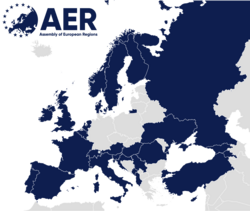Top Qs
Timeline
Chat
Perspective
Assembly of European Regions
European organization From Wikipedia, the free encyclopedia
Remove ads
The Assembly of European Regions (AER) is the largest independent networkng organization of regions in wider Europe. Bringing together regions from 25 countries and 15 interregional organizations, AER is a forum for interregional cooperation.[4]
Remove ads
Historical background
Summarize
Perspective
On 15 June 1985, at Louvain-la-Neuve (Walloon Brabant), 47 Regions and 9 interregional organizations founded the Council of the Regions of Europe (CRE), which would later become the Assembly of European Regions in November 1987 at the second General meeting of the Regions of Europe in Brussels.
The year 1985 was proclaimed by the United Nations as the International Youth Year. The same year AER launched its first programme, Eurodyssey, designed to promote and encourage youth mobility.
In 1990, AER's Tabula Regionum Europae released the inaugural map depicting Europe not solely as a collection of countries but as regions. The following year, the principle of subsidiarity emerged as AER's flagship initiative, advocating for the involvement of regions in European and national decision-making. Its impact was swiftly recognized, culminating in its inclusion in the Maastricht Treaty of 1992.
The creation of the Committee of the Regions (CoR) in 1994 and the Chamber of the Regions in the framework of the Congress of Local and Regional Authorities of Europe (CLRAE) in 1994, exemplified a victory for AER in advocating for the regions in Europe.
In 1995, AER launched a campaign to promote regionalism in Europe. As a result, 300 AER members adopted in 1996 the Declaration on Regionalism in Europe immediately initializing a reference document for new and developing regions.[4]
In 2002, AER presented its position on the “Future of Europe” to the European Convention. AER actively contributed to the drafting of the European Constitution, demonstrating strong political involvement. The final text included all AER proposals, namely
- The recognition of the regions as an important level of governance within Europe.
- The extension of the principle of subsidiarity to regional and local levels.
- The inclusion of regional cohesion in EU's objectives.
In 2008, AER established the Youth Regional Network, Europe's first and only platform of regional youth councils, parliaments, and organizations.
Remove ads
Definition of "Region"
According to the AER statutes, in principle the term "region" refers to a territorial authority existing at the level immediately below that of the central government, with its own political representation in the form of an elected regional assembly.
Members
Summarize
Perspective
Member regions of the Assembly of European Regions are as follows:[5]
As a result of the Russian invasion of Ukraine in 2022, AER suspended Russian members.[6]
Remove ads
List of presidents of the AER
- Albert Castellanos - Catalonia (Spain) - 2023–present
- Magnus Berntsson - Västra Götaland (Sweden) - 2017–2023
- Hande Özsan Bozatlı - Istanbul (Turkey) - 2013–2017
- Michèle Sabban - Île-de-France (France) - 2008–2013
- Riccardo Illy - Friuli-Venezia-Giulia (Italy) - 2004–2008
- Liese Prokop - Lower Austria (Austria) - 2000–2004
- Luc Van den Brande - Flanders (Belgium) - 1996–2000
- Jordi Pujol - Catalonia (Spain) - 1992-1996
- Carlo Bernini - Veneto (Italy) - 1988–1992
- Edgar Faure - Franche-Comté (France) - 1985–1988
Remove ads
See also
References
Wikiwand - on
Seamless Wikipedia browsing. On steroids.
Remove ads


